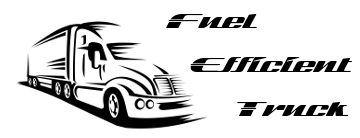Well, maybe not quite yet for ALL US tractor trailers. After all, the adoption rate for wide base single tires on new trailers was only 10 percent as of a couple years ago1. But if sightings during my daily commute are any indication, that day has arrived for bulk transport by tanker. Over 30 percent2 of the tank trucks I see are outfitted with wide base singles (WBS) on every axle, resulting in 10 wheels instead of the usual 18.
For many people, this might come as a surprise. After all, the transportation of liquids, many of them toxic, flammable and/or noxious, would seem to benefit from the safety of additional tires on these mobile pipelines. But this is not the case and I have a few theories on this:
- The weight of bulk loads are adequately carried by a 10 wheeler and doesn’t require additional wheels [ed. note – thank you Cpt. Obvious]
- DOT gross vehicle weight limit of 80,000 lbs. is primarily by axle; although wheel and tire limits should not be ignored by those specifying equipment, there is no regulatory reason for 18 wheels
- Limping to repair is a legal gray area in trucking but is often a ticketed offense, and dangerous since it increases the probability of equipment damage and failure of the remaining tires on that chassis assembly. In reality, I never see a bulk tanker pulled over to the side. I believe the reason for this is….
- …that large bulk fleets have large pools of newer standardized equipment and learn how to manage that equipment for minimum failure while maximizing earnings. I suspect that many of those fleets use tire pressure systems and pull tires out of service at any sign of stress to minimize costly failures, road service, out of commission time, and dangerous and damaging leaks (damaging to the truck, people, infrastructure, environment AND reputation).
If large, sophisticated, bulk transportation fleets are converting their entire operations to wide base tires, it is clear that they are making this decision after extensive research, and economic and safety calculations which confirm the wisdom of the decision.
More broadly, the transition from 18 wheels to 10 wheels isn’t going in a straight line for semi-trailer fleets more generally. The heterogeneity of heavy duty semi-trailer equipment on the road means that in addition to 10 wheelers, there will be plenty of 18 Wheelers, 14-wheelers which combine wide-base converted tractors (from 10 wheels to 6 wheels) with non-converted trailers (8 wheels), and 14 wheelers which combine non-converted tractors (10 wheels) with wide-base converted trailers (from 8 wheels to 4 wheels). Also seen on the road in 2014 and 2015 were many variations of doubles (two trailers hooked together behind a tractor) combining traditional duals and wide base singles on the various chassis. A growing multitude of wheel combinations will be with us for the foreseeable future.
As the real world success of wide base single tire adoption becomes widely known and impartial research is more widely distributed, it is likely that adoption of these technologies will increase at a faster pace. But given that a blend of equipment will be around for years or even decades, perhaps a more accurate title would have been “Long live the 18-, 14- AND 10-Wheeler”.
1 Costs and Adoption Rates of Fuel-Saving Technologies for Trailers in the North American On-Road Freight Sector, Ben Sharpe (ICCT) and Mike Roeth (North American Council for Freight Efficiency), Page 15, Table 6: Summary of interview responses on trailer technology costs and level of adoption
2 Below are the results from ten randomly chosen days during which I counted and recorded the number of bulk transports and the number of those bulk trucks running wide base single tires on some or all eligible axles (most running WBS tires were running them on all eligible axles), along with a totals and percent calculation in the last row.
| Tankers Counted | Tankers with WBS | Percent WBS |
| 3 | 2 | |
| 3 | 2 | |
| 10 | 5 | |
| 10 | 5 | |
| 4 | 0 | |
| 2 | 1 | |
| 2 | 1 | |
| 2 | 0 | |
| 4 | 0 | |
| 3 | 0 | |
| 43 | 16 | 37 % |
